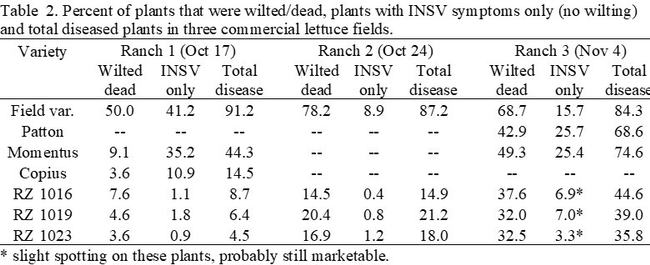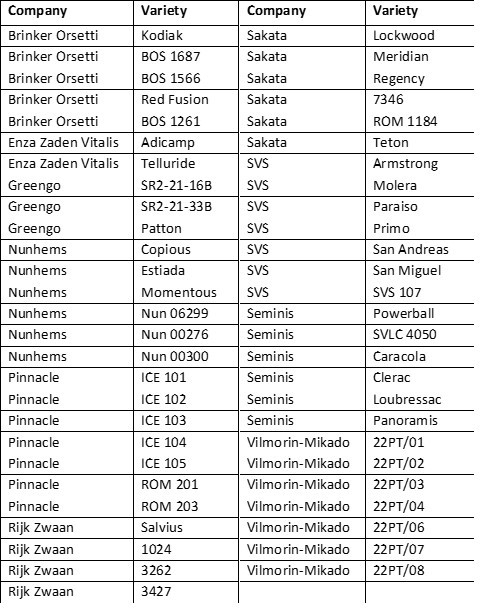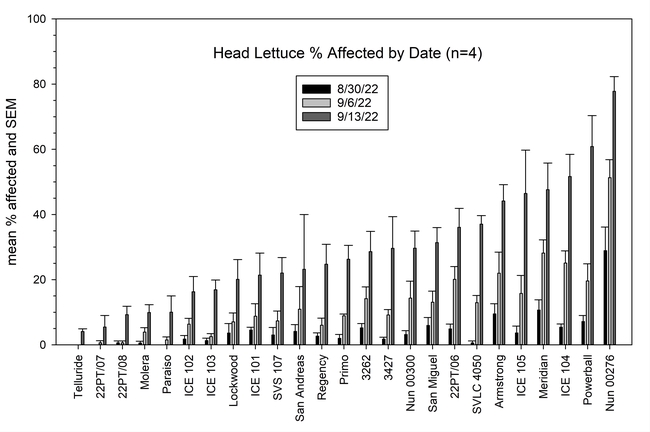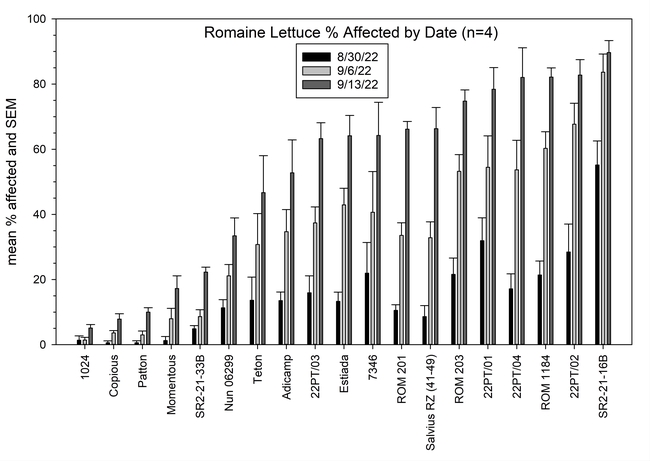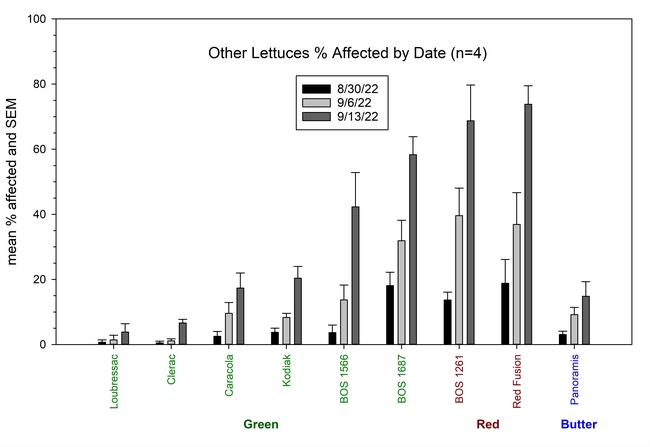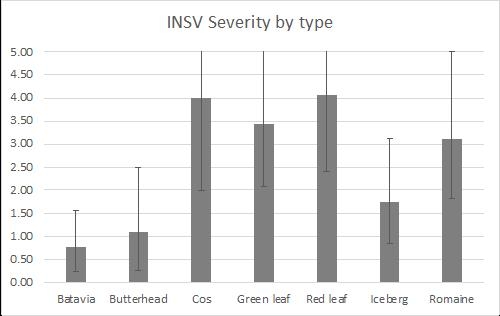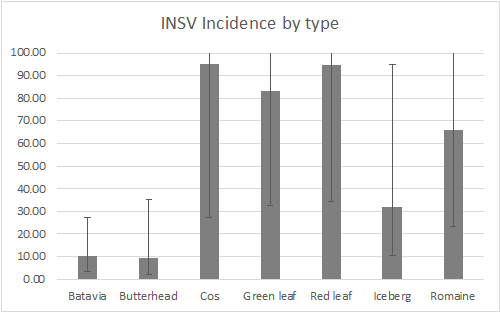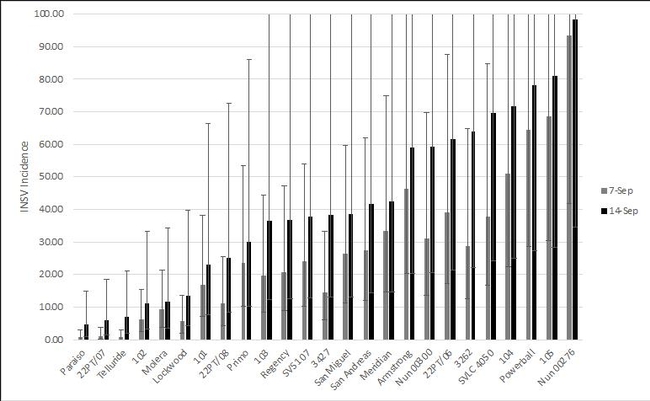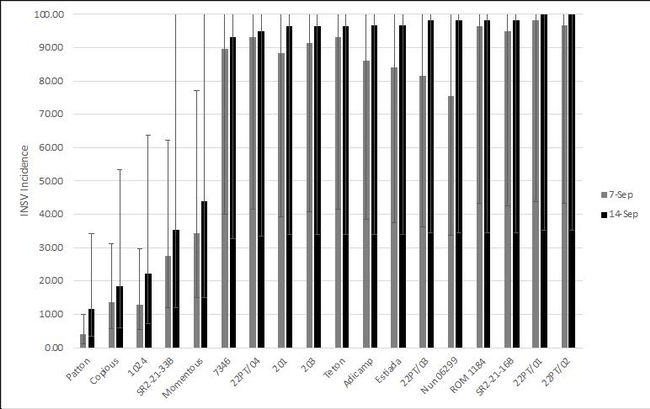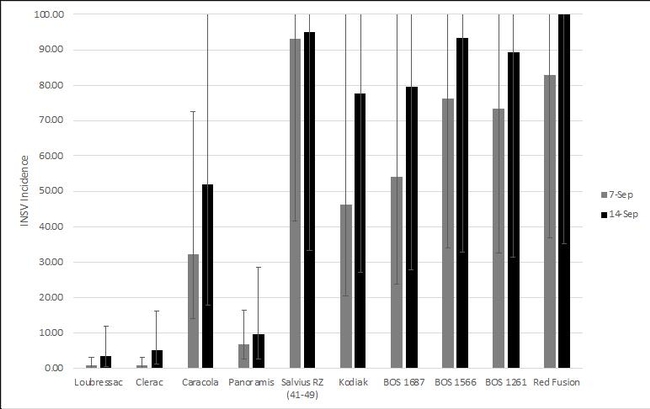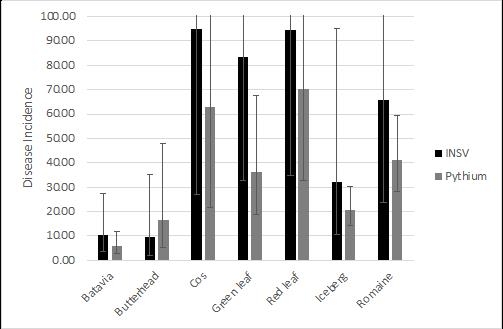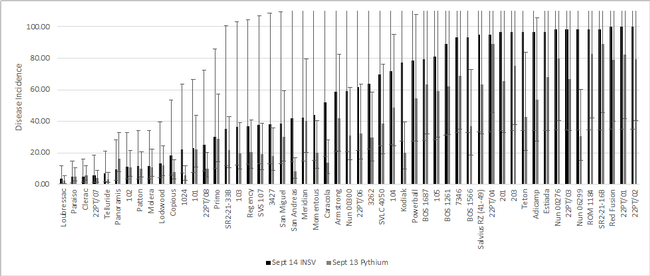Richard Smith1, J.P. Dundore Arias2, Kelley Richardson3, Yu-Chen Wang1 and Tricia Love4
1 - Farm Advisor UCCE Monterey, 2 - Plant Pathology Professor CSUMB, 3 - Research Geneticist USDA ARS, Salinas and 4 - Staff Research Assistant, UCCE Monterey
Summary: A lettuce variety trial was conducted at the USDA Spence research station on a site that had significant infection with Lettuce Pythium wilt (Pythium uncinulatum) in 2021. Visual evaluations of lettuce plants that were wilting or dead showed that a number of head lettuce varieties had significantly tolerance to Pythium wilt: 22PT/07, Paraiso, Telluride, Molera and 22PT/08. Romaine varieties were generally more sensitive to Pythium wilt than head lettuce varieties, but some varieties that held up to the disease included Copious, Patton, 1024 Momentus and SR2-21-33B. Two green leaf types also held up well to Pythium wilt: Clerac and Loubressac. INSV incidence (percent symptomatic plants) was 89% correlated with Pythium incidence. The most resistant Pythium varieties were also the most INSV resistant. While INSV severity and incidence in crisphead type varieties were significantly lower than in romaine varieties, on average, significantly more crisphead samples tested positive in laboratory tests for the virus than romaine samples. Laboratory evaluations of infected plants confirmed the dominant soilborne disease at the site was Pythium wilt. Pythium wilt was also isolated from plants that had no obvious visual symptoms in the above ground portion of the plant. No Fusarium wilt was detected in any plants sampled. In separate evaluations on commercial farms, levels of Pythium wilt increased to extremely high levels by the end of the production season in the Salinas Valley in 2022. Even varieties that were shown to be highly tolerant in the Spence variety trial showed significant susceptibility under severe late-season conditions.
Methods: Lettuce Variety Trial: A lettuce variety trial evaluating tolerance to Pythium wilt was conducted at the USDA Spence Research Station on a site that had significant infection with this disease in 2021. The trial was planted on July 12, 2022 using a modified planter on a two-bed sled with Stanhay planter shoes; seed was fed to the shoes by dropping seed by hand into a funnel and hose that carried the seed down to the shoes. Seed was pre-weighed out in coin envelopes and arranged in boxes to follow the plot map for the plot. Seed was received from 10 seed companies and a total of 53 varieties were included (Table 1). Each plot was one forty-inch bed wide (with two seedlines) by 25 feet long. There were four replications of each variety arranged in a randomized complete block design. After planting, thirty gallons of 7-7-0-7 was applied as an anticrustant and 3 pints of Kerb wase applied to control weeds. The field was sprinkler irrigated until August 9th when drip tape was installed and was used for the remainder of the crop cycle to irrigate the field. Two fertigations of 120 lbs of N/A as UN 32 were applied to the field.
Total plants in each plot were counted on August 9. Visual evaluations of Pythium wilt were conducted on three dates: August 30 and September 6 and 13 by counting the number of plants that exhibited wilting per plot which was converted to mean percent infected plants per plot by dividing by the total plants. Laboratory confirmation of Pythium wilt was conducted by collecting wilting plants from one rep of the plot on August 30 and September 6, and plants from all plots (regardless of visible wilting symptoms) on Sept 13. These plants were evaluated by J.P. Dundore-Arias Plant Pathology lab at CSU, Monterey Bay. On September 13, selected plants that were wilting, but showed no signs of obvious Pythium root rot and were therefore suspected of having a vascular wilt were sent to Alex Putnam who evaluated them for Fusarium wilt. Also on September 13, four plants were sent to the TriCal Diagnostic lab for general wilt evaluation. The plots were also evaluated for INSV by Kelley Richardson of the USDA. Twenty plants per plot were flagged in three replications (60 plants total). Each was rated for INSV symptom severity (0-5, 0=no symptoms, 5=dead) on September 7 and 14. INSV incidence was calculated per plot as the percent of plants showing symptoms (severity of 2 or more). On September 14, leaf tissue was collected from three plants per plot per replication of the most resistant lines (lowest severity) to test in the USDA lab for the presence of INSV using ELISA.
On-Farm Evaluations: Three on-farm varieties trials conducted by seed companies were evaluated as described above. The focus of the evaluation was to observe the interaction of INSV and Pythium tolerant/resistant varieties under conditions of high disease pressure. The dominant disease at the three sites was Pythium wilt which was confirmed by visual symptoms of rot on the roots. The plants were also evaluated for the presence of Sclerotinia and vascular wilts.
Table 1. Varieties included in the trial.
Results: Lettuce Variety Trial, Visual evaluations: showed significant differences among the varieties of head, romaine, and leaf type lettuces (Figures 1, 2 and 3). Head lettuce varieties differed in susceptibility, but also on the timing of infections. For instance, a number of head lettuce varieties had low levels of infection on August 30 but by September 13 exhibited a high diseases incidence with a large number of infected plants (Figure 1). 22PT/07, Paraiso, Telluride, Molera and 22PT/08 all had ≤10% on the last evaluation date (63 days after first water). Romaine lettuce were more sensitive to Pythium wilt and only Copious, Patton and 1024 had levels of Pythium wilt ≤10%, while Momentus and SR2-21-33B had levels ≤20% (Figure 2). Two green leaf lettuce types maintained levels of infection ≤10%, Clerac and Loubressac. Laboratory evaluations:Pythium wilt was consistently isolated from infected plants collected on the three evaluation dates. The number of Pythium-infected plants increased over the weeks and by the last evaluation, the pathogen was isolated from nearly all plants, regardless of having mild to severe foliar wilting or root rot symptoms. On September 13, selected wilting plants that did not have obvious symptoms of Pythium wilt were sent to Alex Putnam's lab, but of the 13 plants evaluated none had Fusarium wilt. One plant sent to the TriCal Diagnostic lab for general wilt evaluation was confirmed for Verticillium; plants with symptoms associated with a vascular wilt were not common in this trial.
There were significant differences amongst varieties for INSV severity and incidence at both rating dates (<0.0001). On average, batavia and butterhead lines had the lowest INSV severity and incidence (Figure 4). On average, crisphead varieties had significantly lower severity (1.76) and incidence (32.23%) than romaine types (3.12, 66.03%). This matches previous years' trends that crisphead varieties, on average, are more resistant than romaine. Cos, green leaf, and red leaf varieties had high severity and near 100% incidence. It is important to note that the two red leaf varieties tested had red and green leaves and were not completely red. This might explain why this data does not match previous trends of red leaf varieties having lower severity than green. Of the crisphead varieties tested, Paraiso, 22PT/07, and Telluride had the lowest INSV severity and incidence below 10% (Figure 5). 102, Molera, and Lockwood had low INSV severity and incidence below 20%. Patton and Copious were the only romaine varieties with low INSV severity and incidence below 20% (Figure 6). No romaine types had incidence below 10%. 1024, SR2-21-33B, and Momentous had INSV severity below 2 and incidence below 50%. Of all varieties tested, the Batavia varieties Loubressac and Clerac had the lowest INSV severity and incidence below 5% (Figure 7). ELISA was run on leaf tissue from the most resistant lines to check for INSV. Only Loubressac had all negative samples (Table 3). Surprisingly, romaine varieties, on average, had fewer positive samples than crisphead varieties. Paraiso, which had one of the lowest INSV severities and incidence below 5% had 83.3% positive samples.
The September 13 Pythium and September 14 INSV datasets were analyzed together to look for similar trends. Data sets were 89% correlated. When separated by type, batavia and butterhead varieties on average had the lowest INSV and Pythium incidences and crisphead varieties had significantly lower INSV and Pythium incidences than romaine varieties (Figure 8). The most INSV resistant varieties were also the most Pythium resistant (Figure 9).
On-Farm Evaluations: INSV (Rijk Zwaan - RZ) and Pythium (Momentus, Copius and Patton) tolerant/resistant varieties were evaluated in trials in commercial fields at the end of the growing season in the Salinas Valley during the period of most intense disease pressure. The varieties were compared with a susceptible variety. At Ranch 1 all varieties had greatly reduced wilted/dead symptoms compared to the field variety (Table 2). The Rijk Zwaan varieties had much reduced INSV symptoms as well. Ranch 2 had substantial wilted/dead plants but less INSV than Ranch 1; the Rijk Zwaan varieties had wilted/dead plants that ranged from 14.5% to 20.4% compared to 78.2% for the field variety. At Ranch 3 the field variety had 68.7% of wilted/dead plants and 15.7% with INSV only symptoms. Patton and Momentus had 42.9 and 49.3%, wilted/dead plants, respectively and did not have fewer INSV infected plants than the field variety. The Rijk Zwaan varieties ranged from 32.0 to 37.6% wilted/dead plants but had much fewer INSV only infected plants. The INSV symptoms on the Rijk Zwaan varieties showed very slight INSV symptoms (few spots on outer leaves) but were confirmed with Agdia strip assays. Plants at Ranch 3 were also evaluated for Fusarium and Verticillium wilts, but none were positive. The soil was also evaluated, and no Fusarium wilt of lettuce was detected and Verticillium levels ranged from 2.1 to 2.5 ms/gram of soil, which is not sufficient to cause disease on lettuce.
Figure 1. Visual evaluation of Pythium wilt: Mean percent infected plants of head lettuce per plot on three dates.
Figure 2. Visual evaluation of Pythium wilt: Mean percent infected plants of romaine lettuce per plot on three dates.
Figure 3. Visual evaluation of Pythium wilt: Mean percent infected plants of leaf lettuce per plot on three dates.
Figure 4. INSV severity (0-5 scale) and incidence (0-100%) of all lines separated by lettuce type. Final rating on September 14. (Error bars represent 95% confidence intervals)
Figure 5. Mean INSV incidence (percent infected plants) of crisphead lettuce on two rating dates. (Error bars represent 95% confidence intervals)
Figure 6. Mean INSV incidence (percent infected plants) of romaine lettuce on two rating dates. (Error bars represent 95% confidence intervals)
Figure 7. Mean INSV incidence (percent infected plants) of other lettuce types on two rating dates. (Error bars represent 95% confidence intervals)
Figure 8. Mean INSV and Pythium incidence of all varieties separated by lettuce type on the final rating date. (Error bars represent 95% confidence intervals)
Figure 9. Mean INSV and Pythium incidence of all varieties on the final rating date. (Error bars represent 95% confidence intervals)